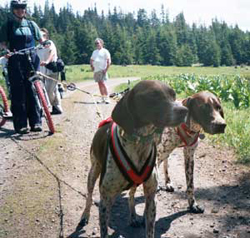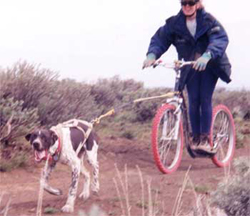
I've only been running 2 dog teams dogs regularly since fall of 1998 besides doing a little work here and there to help someone's dog get started. Obviously I can't tell you how to train for the Iditarod or the Open North American... or any other race for that matter. Races for a team this small normally only cover 2-3 miles and we quickly run much further than that in training, so up until this year (2002) I haven't bothered. We did bandit the second day of the Cascade Quest sporting class one year as the sole skijoring team (17 miles of ridge climb and descent), and we've participated in a few longer scooter fun runs and hope to do more.
But I have succesfully trained my dogs from scratch all their commands and to work hard and consistantly. Oddly enough, on group runs we are often faster than larger teams simply because the dogs do just that: work hard and consistantly. You can do it to with just a little planning, but it helps to have a mentor with really good dogs to prove what is really possible and further challenge you.
If you're new to the sport, please consider aquiring only 2 or 3 the most genetically endowed dogs you can find and sticking with them for a few years. RESIST THE TEMPTATION TO EXPAND YOUR KENNEL RIGHT AWAY. You'll learn to be a better trainer and the dogs will get more attention. Smaller kennels and teams are typically less hassle to look after, cost less to mantain properly, allow more time per dog, are easier to transport, and more manageable in crummy trail conditions.
Contrary to what many people will tell you, 10-20 mile runs with 2-4 dogs is quite doable and depending on your dogs and your training schedule you may be able to go well beyond that. When Iditasport extreme featured skijoring, 50 mile days were typical- and these were 3 dog teams!
OK, you've decided to stick it out with the handful of dogs you've got, but you want them to be able to go the distance and pull stumps when you need it. What to do? Here's a few things I've learned:
- Start as
early as possible free running the dogs to get them a little muscled up
before heavy fall training. I use a mountain bike (although the dogs require
electric collars to keep them from running game or getting squished by
log trucks).
- MAKE A MUSHING LOG. I record temps, times, speed, types of runs, miscellaneous
notes, etc. in a spreadsheet and can easily see cumulative mileage for
the month and season. You will be able to look back over the season and
see what worked, what didn't, and make objective changes from there.
- TRAINING YOUR TEAM TO PULL HARD OVER DISTANCE IS THE MOST CRITICAL
ASPECT OF SMALL TEAM SUCCESS. Concentrate the first few weeks of the
season on control and slow hard pulling until they get noticably stronger
and more muscled up. This will prevent injuries and give you a chance
to teach them to PULL HARD ON COMMAND. Don't settle for anything less
than what they're capable of- two dogs can pull a #130 cart up any hill
I can find.
- Add speed back in alternating with harder runs once fall training progresses.
This is the time to mix in flat/hills/scooter/cart etc.
- MASSAGE. They'll learn to put up with your hands on them everywhere,
and you might find some soreness you wouldn't otherwise be aware of.
- If your available trails jump in milage, you can "fudge" a
milage increase by taking a longer break halfway, running it in colder
weather or at night, doing out and backs instead of the whole thing. Don't
make excuses- get creative.
- I try not to take more than 2 days off in a row, but if the dogs need
a rest or work gets frantic, don't panic. Consistant training over the
entire season will give results... one day a month messed up doesn't mean
much.
- BUT DON'T CHEAT YOURSELF EITHER. Get good mileage estimates on your
trails and use your watch to know how long it's taking you with the little
cookie breaks and such. While missing a day here and there isn't bad,
missing many is counterproductive- and exaggerating milage doesn't do
anyone favors.
- FEED MEAT. I could get into a long explination, but even 4 ounces of
meat added to kibble with make such a difference you'll just nod and smile
when you read it somewhere else next year.
- LISTEN TO YOUR DOGS. They're ALWAYS talking to you. Hanging out in the
living room or bedroom every night together is one of the many perks of
small teams... take time to learn from them, you won't be sorry.
Whoa, there aren't any gimmicks here are there? Which brings me to my closing point:
THE SECRET IS: THERE IS NO SECRET- JUST HARD WORK!
